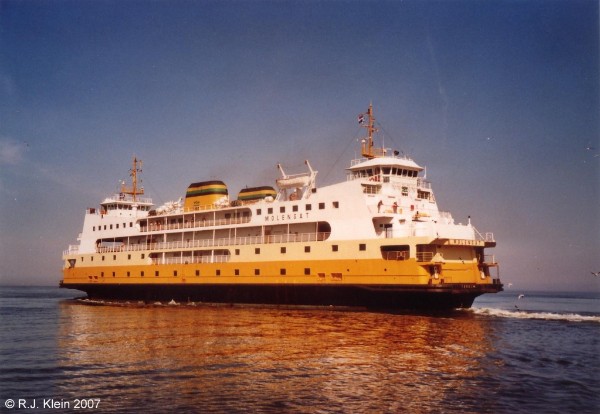Molengat
The first doubledeck carferry for the TESO company was built in The Netherlands at the Verolme Shipyard in Heusden. The idea for doubledeck ferries came from Theo Hoogerheide, one of the companies directors. His idea was not very popular by everyone, as mostly the islanders themselves, owners also of the TESO company, feared that the community of Texel would be flooded with tourists when this extra capacity came available. But the problems were there and a solution had to be provided, as waiting times for the smaller ferries Texelstroom and Marsdiep, both build in the mid-1960's, was sometimes up to eight hours. For tourists, this was a reason to avoid the island and for people who's life was devided by the sea, it was very inconvenient. Demonstations werd organized at Texel, something the islanders had never seen before, but eventually, it was obvious that the route had to be improved.
Below, Molengat as seen in the summer of 2007. She is painted in the traditional colours of TESO.

At the 17th of july 1978, the ship was ordered from the wharf at Heusden. Her keel was laid in early 1979 and she was launched at the 19th of june 1980. The ship had a lenght of 88,26 meters and she was 18,02 meters wide. Her draft was 4,45 meters and her tonnage measurement was 3254. Her normal service speed of 13 knots was adequate for the 20 minut crossing from Den Helder to Texel and she had capacity onboard for 1250 passengers and 190 cars. She was driven by 6 eight-cylinder MaK dieselengines, operating two Voith Schneider propellers, one on the front and one at the rear side of the ship for better manouverability.Her tonnage and capacity doesn't seem that huge, but in comparissement with the earlier ships, that could carry 750 passengers and 70 cars, it was a huge improvement. None of the 1960's-built ships left the route, as they were employed as reserveships for times when the new ship, named Molengat, was out of service for maintainancework. They were also used as extra ferries in the busy periods and were used as such untill the second doubledeck ferry Schulpengat arrived in 1990, after which they were sold.
Due to lawsuites and more protsts against the double deck ferries, the ship wasn't able to sail at full capacity untill 1986, because the changes to the loading dock, most important the building of the double-decked loadingbridge, were delayed considerably. Because of this, it the first six years of operation, only the lower cardeck could be used.
Not many mishaps or glories can be named here, as the ship of course only sails one route of only twenty minutes. Just in january of 2007, she had the mishap of colliding with the loading bridge at Den Helder, damaging both the ship and the bridge. High waters and the heavy storm that was raging that day, caused TESO to suspend all services for the rest of the day and with TESO providing the only service to and from the island, this was a huge inconvenience. Later, TESO admitted that there had been technical problems causing the collission and afterwards, the company had acted inadequate enough at the situation.
In 2010, the ship was sold to a company named Halani Shipping from India, who were going to use the ferry as a diving supportship in the Persian Gulf. For this, she had to be rebuild considerably at Singapore. During rebuilding, the ship was broken up untill there only was the flat hull left and then rebuild so she was not a little bit recognizable as the ferry she once was. In 2009, after the rebuilding, she was renamed Halani 1 and in february of 2010 a contract was signed with Acegy/ EXXON to use the ship near the coast of Angola as supportship for deepsea drilling. As a so-called DPIII-vessel, she is able to hold herself in position with her own propellers, making it posible to perform works at sea without being anchored.

